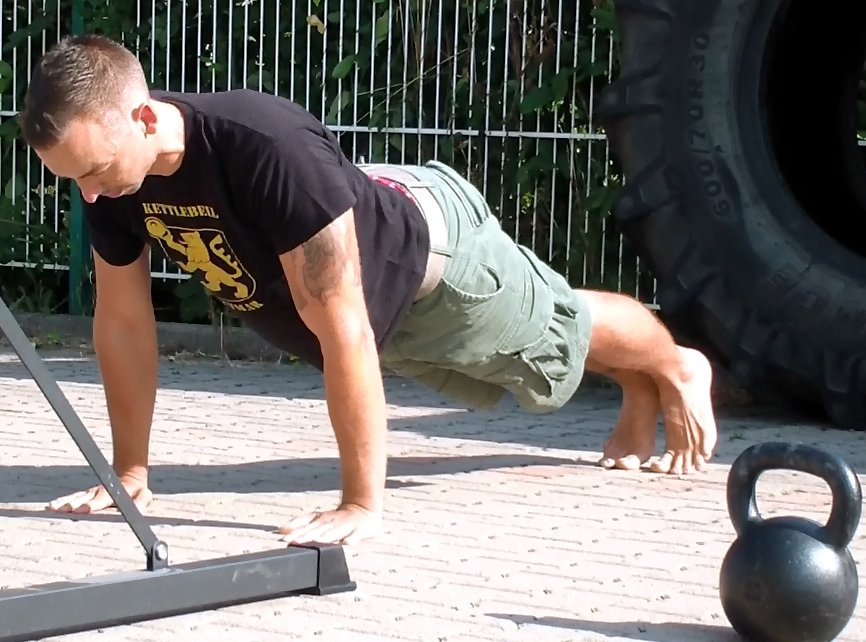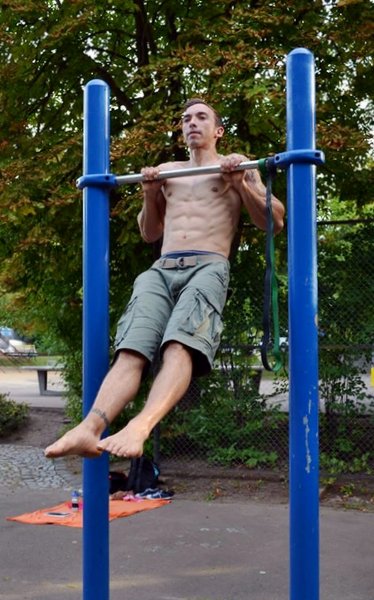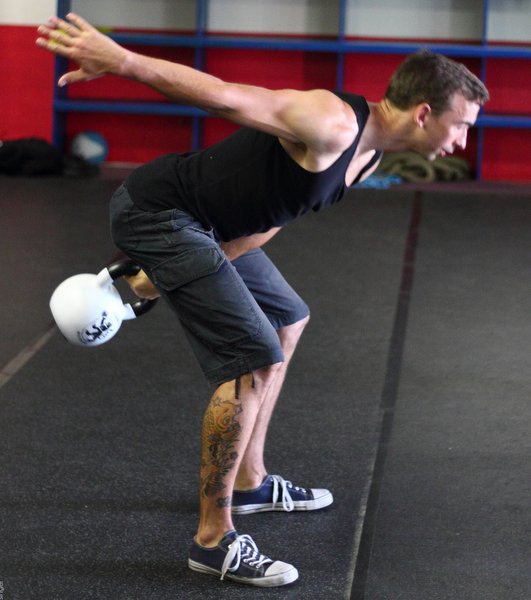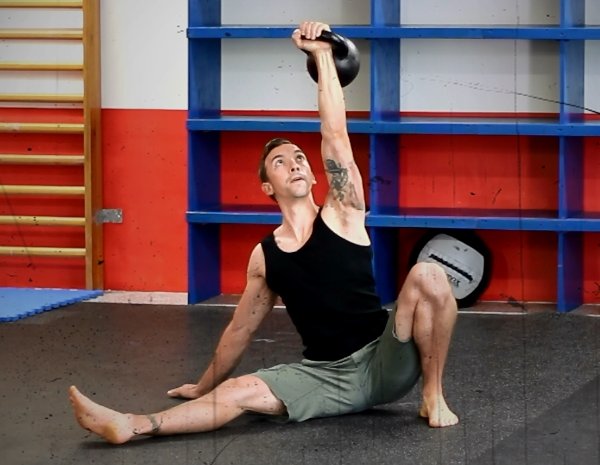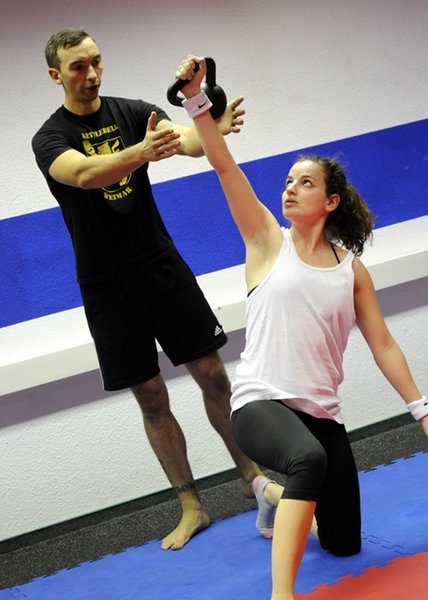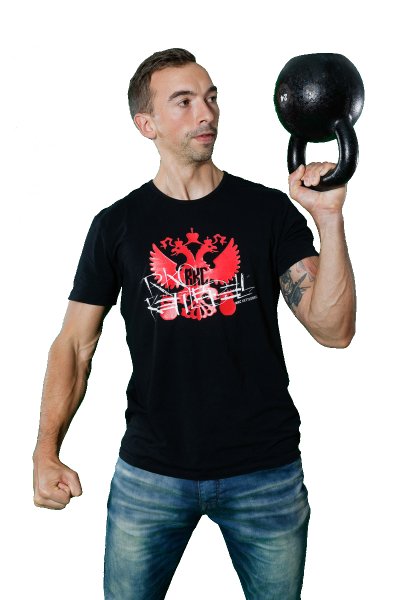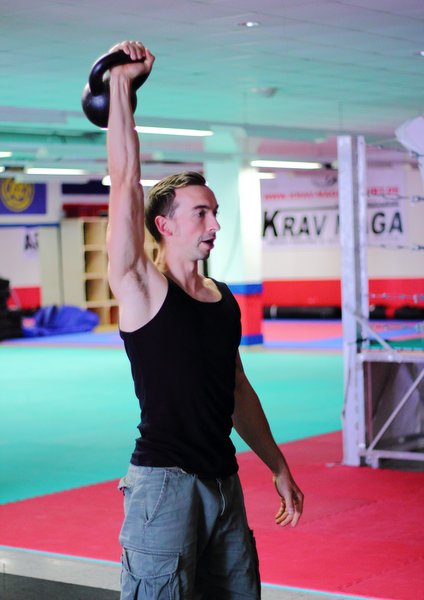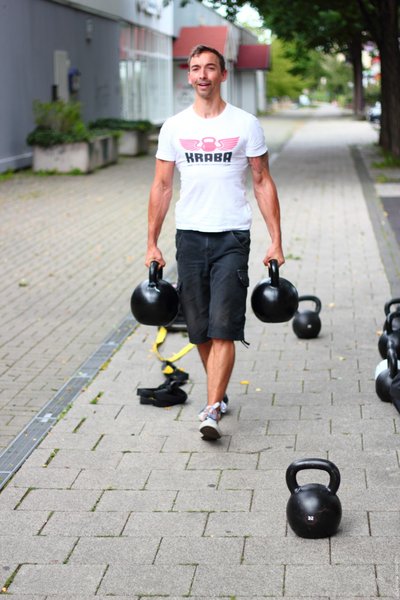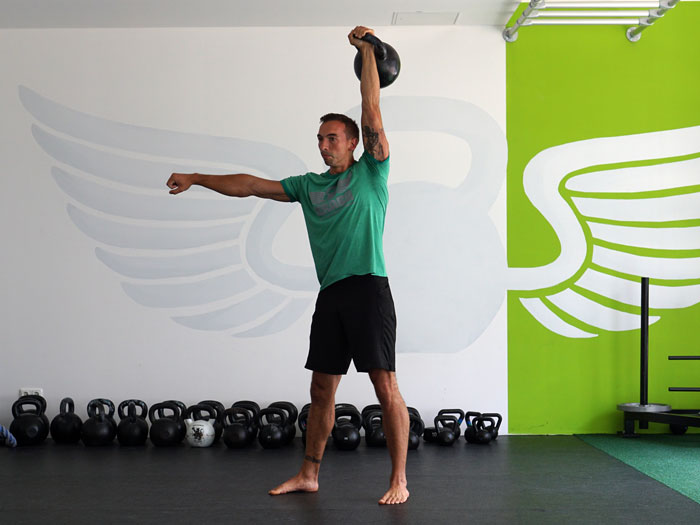
Kettlebell exercises are much more common in fitness these days because of the RKC, CrossFit, strongman and functional training. But, only truly strong athletes will be able to lift heavy kettlebells overhead without risking injury.
When I began my training a few years ago, I hated it. No matter where I looked, everybody was stronger than me—at least that’s what I thought when I saw what others were lifting. But, the further I went down the path of strength training, I discovered a real secret. I learned why—after months of training—I still lifted lighter weights than the other guys (and girls).
The difference was that I pressed the weights with very strict form. I would clean a kettlebell and then press it until my arm was straight overhead. While this is an extremely effective way to train your body, it is not really useful for lifting very heavy weights.
If you want to move big kettlebells, you have to be creative. You’ll need to look for effective exercises and movements that allow you to use more of your muscles. This post will outline the four best exercises I’ve found for this purpose.
1. The Get-Up
Turkish wrestlers and aspiring athletes who trained with them used this exercise to prepare for the hard and demanding sport-specific wrestling training. If an athlete couldn’t “get up” with at least half of his body weight, he wasn’t allowed to participate in wrestling training. Being able to lift a lot of weight is just one advantage of the get-up. Your body will learn to work as a unit, and every muscle is involved with this movement. When I first did the get-up with a kettlebell, I chose the same weight I was using for strict presses. After a few weeks, I increased that weight by 100%.
Since one arm is holding the weight straight overhead during the entire get-up exercise, it strengthens and stabilizes your shoulder muscles. When you’re able to do the movement correctly and smoothly, then the goal of using half your body weight is absolutely realistic.

Performing the Get-Up
- Start on your back, lying on the ground.
- Safely pick up the weight, and extend your arm to press the weight overhead.
- Push with your supporting leg to the side and roll up on your elbow.
- Sit up straight.
- Bring the knee of the extended leg under your hip.
- Be sure your upper body is upright, and rotate it straight forward.
- Stand up into a shoulder-width stance.
2. Bent Press (Advanced)
Old time strongmen and athletes of the 19th century did tremendous feats of strength with this exercise. You don’t see it very much these days, despite its many advantages. (The bent press is a very advanced exercise and should only be attempted when the kettlebell lifter is ready. Find an RKC-II instructor near you for help and coaching with this movement.)
But, if it is safe and appropriate for the trainee, the carryover from the bent press to other movements is gigantic. It also enormously improves hip and thoracic spine mobility. Another special thing about the bent press is that it has no “perfect form”. Everyone does it a bit differently. Although the process is always the same, there are three options: hip dominant (similar to the windmill), thigh dominant (closer to a squatting pattern), or a version that incorporates both movement patterns.

Performing the Bent Press:
- Bring the weight up to the chest safely (the “rack position”).
- Position your arm onto your big back muscles and let it remain there.
- “Sit” under the weight by opening or hinging the hip and rotating the upper body until the arm holding the kettlebell is completely straight.
- Straighten the hip and legs to return to the standing position.
3. Push Press
The push press bears the most resemblance to the strict press. But with the push-press, the upper body muscles only start to work when the kettlebell is already on its way up. The force of the push press comes from the legs and the hips. A small knee dip followed by an explosive hip extension transfers the force to propel the kettlebell overhead.
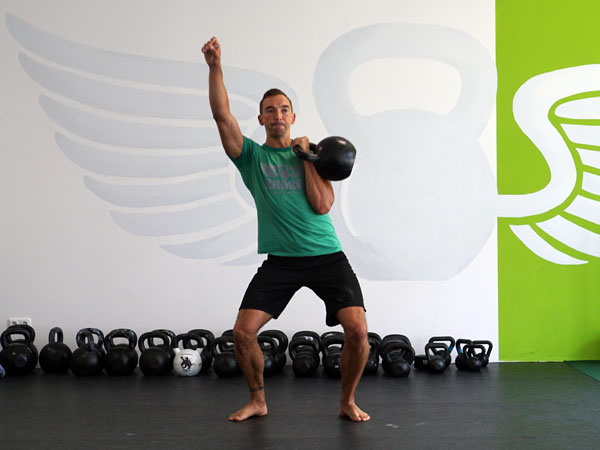
Performing the Push Press:
- Bring the weight up to the chest safely (the “rack position”).
- Hinge the hips and bend your knees slightly (about one quarter of a squat).
- Explosively extend legs and hips (“bump” see the photo above).
- Straighten the arm. After the bump, the handle of the kettlebell should be at about the height of your forehead, before you straighten the arm.
4. Jerk
The jerk is an exercise to bring up the most weight overhead with two kettlebells. It takes the upper body muscles responsible for the press almost completely out of the game. Everything in the jerk is similar to the push press up until the bump. When the kettlebells are forehead height, you have to do another dip with the knees and hips—and simultaneously extend both arms.
This exercise is super complex, but also allows you to use a lot of weight.
Performing the Jerk
- Safely clean the kettlebells up to the chest (the “rack position”).
- Hinge the hips and slightly bend your knees (about one quarter of a squat).
- Explosively extend your legs and hips (“bump”).
- Bend your knees and hinge your hips again when the kettlebell reaches your forehead. Simultaneously extend your arm.
- Extend your legs and hips to stand up straight with the weight overhead.
Prerequisite Requirements for Safely Lifting Heavy Kettlebells Overhead:
Before you try these exercises, there are prerequisite requirements for lifting heavy kettlebells overhead—which include a certain level of mobility and stability to prevent overtraining or injury.
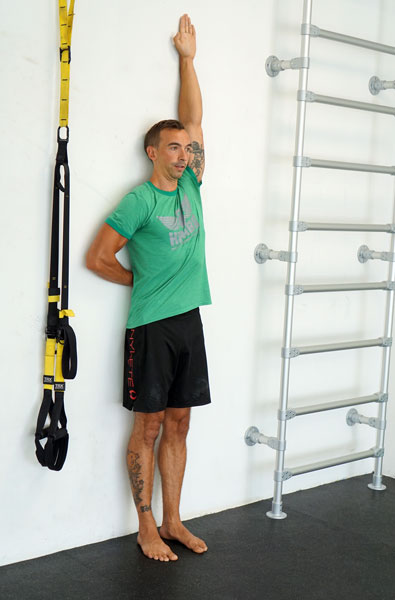
Test your overhead lockout position:
- Stand with your back facing a wall with your heels about 5cm (about 2 inches) from the wall.
- Your buttocks, upper back, shoulders and back of your head are touching the wall.
- Hinge the hip so that you ‘’pinch’’ your hand to the wall. The pressure on the hand should be there during the entire exercise.
- Put your other hand straight up overhead.
When the wrist of your fully extended arm touches the wall while your back remains stable, you will have fulfilled the mobility requirements. If you’ve run into trouble here, first work on your thoracic spine mobility and shoulder joints. To safely lift heavy kettlebells overhead, you will also need stable shoulder joints and a strong core musculature. You should have also mastered the basic kettlebell movements: swing, get-up, clean, press, squat, snatch.
The get-up is the best exercise to prepare your shoulders for heavy weights. When you master the get up, you will build a strong foundation for lifting heavy kettlebells. You can even increase the effectiveness of the exercise by adding overhead walks to your get-up sessions. For example, walk with the kettlebell overhead every time you are in the standing position of the get-up.
When a get-up with half your bodyweight is no problem for you anymore, and you are safe in the kettlebell basics, you are ready for the bent press, push press and jerk.
When Training with Heavy Kettlebells, Movement Quality is Essential
The movement patterns of the get-up, bent press, push press and jerk are complex. Many joints and big muscle groups have to work together perfectly. Before you can load these movement patterns with heavy kettlebells, you should master the movements. You simply can’t afford to stop and think about what you have to do next while you are holding a heavy kettlebell. The best way to avoid mistakes is to do everything correctly from the start. Be a professional and learn the exercises from a qualified coach.
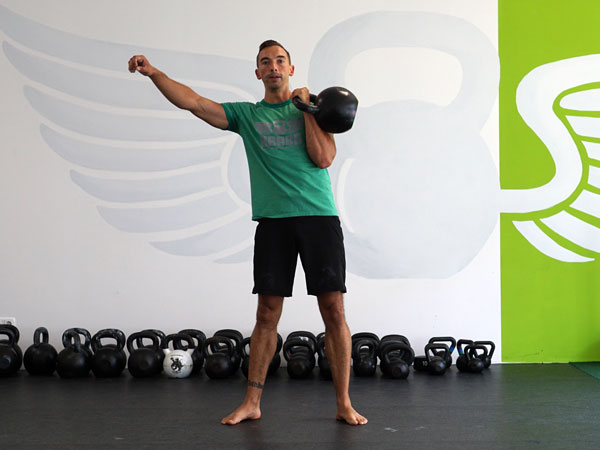
How to Use These Exercises:
The movements we’ve discussed in this blog post can be divided into two categories: skill and power. Skill and power exercises belong at the beginning of your training routine. They require high focus, and we want to lift heavy kettlebells with these exercises. It’s a bad idea to tackle this combination while fatigued.
The get-up and bent press are in the skill category. They are complex movements that involve many muscle groups and joints. They are also performed slowly and under high tension. After warming up, do perfect repetitions in turns, always starting with your less strong side. One to a maximum of five sets will do a fine job. After ten total repetitions (five for each side), move on to other exercises.
The push press and jerk are power exercises. While these movement patterns are less complex, you need a lot of explosiveness and power. After warming up, do perfect repetitions in turns, always starting with your less strong side. One to a maximum of five sets will do a fine job. After ten total repetitions (five for each side), move on to other exercises.
Important Rules:
- Be sure to fulfill the stability and mobility requirements for the overhead movements before attempting them—especially with heavy kettlebells.
- Master the basics!
- Learn all of the described movements from a qualified coach.
- Always practice while fresh, with high focus. Aim to improve a little at every training session.
If you follow these rules, you will surely draw the admiration of others and have the best workouts of your life. Now that you know four exercises for lifting heavy kettlebells, go and lift your training skills to the next level.
***
Sebastian Müller, RKC Team Leader, and PCC Instructor is a personal trainer in Erfurt (Germany) and teaches seminars all over Germany. After 16 years of training he founded the first kettlebell studio in his federal state. He is the head coach of KRABA Erfurt (“Strength and Movement Academy”) and a passionate blogger. His focus lies on what he enjoys the most: to inspire people for simple training and making it an important part of their lives! Translation by Martin Breternitz HKC, KRABA Erfurt
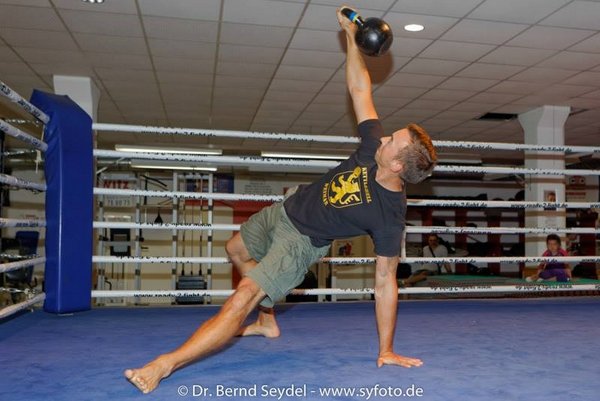
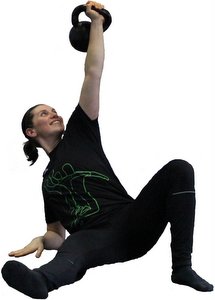 Your body learns to work as a whole unit when performing a Turkish get-up.
Your body learns to work as a whole unit when performing a Turkish get-up.